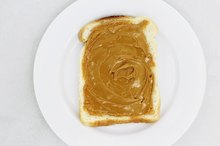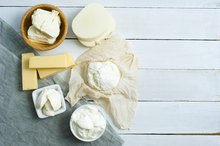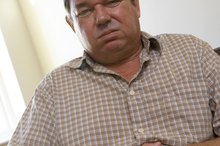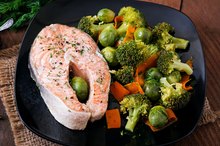How The Body Works Without the Gall Bladder
Function of the Gallbladder
Shaped as a pear-shaped sac, the gallbladder lies underneath the liver. This small organ stores a substance known as bile that's produced in the liver. A digestive liquid, bile neutralizes the acids and binds together the fats in partially digested food. As a valve in the bile duct opens, bile flows into the cystic duct from the gallbladder. It flows alongside the common bile duct and then into the portion of the small intestine known as the duodenum.
If you are experiencing serious medical symptoms, seek emergency treatment immediately.
- Shaped as a pear-shaped sac, the gallbladder lies underneath the liver.
- As a valve in the bile duct opens, bile flows into the cystic duct from the gallbladder.
Gallstones
Peanut Butter & the Gallbladder
Learn More
If cholesterol levels are high enough, the cholesterol can crystallize, forming gallstones. Although gallbladder stones in themselves may not cause pain, when they lodge in the cystic duct or bile duct, they can become inflamed and painful. Symptoms of gallstones include pain coming from the upper right portion of the stomach, which can spread up to the right upper back and shoulder blades. Pain comes and goes ranging from mild to unbearable, often growing worse after eating. Gallstones are confirmed by having an ultrasound done on the belly area.
- If cholesterol levels are high enough, the cholesterol can crystallize, forming gallstones.
- Although gallbladder stones in themselves may not cause pain, when they lodge in the cystic duct or bile duct, they can become inflamed and painful.
Gallbladder Removal
Often surgery is needed to remove the gallbladder when gallstones cause extreme discomfort. Loretta Lanphier, a doctor and clinical nutritionist notes that about 750,000 gallbladders are surgically removed in the United States yearly. A cholecystectomy is the term for the surgical procedure of removing the gallbladder. Usually surgery is done by laparoscopy as opposed to open surgery.
- Often surgery is needed to remove the gallbladder when gallstones cause extreme discomfort.
- A cholecystectomy is the term for the surgical procedure of removing the gallbladder.
Functioning Without a Gallbladder
Reasons For a Gallbladder Removal
Learn More
Because a cholescystectomy doesn't change how your digestive system manages fat metabolism, removing your gallbladder doesn't have a major effect on your body. Before your gallbladder is removed, bile produced by the liver is released in small quantities when fat is consumed. However, when you don't have your gallbladder for storage, bile is constantly released into the small intestine. It's here in the small intestine where most of digestion occurs. In other words, because the gallbladder isn't a crucial organ, removing it doesn't cause major changes, although you do need to cut back on fat intake.
- Because a cholescystectomy doesn't change how your digestive system manages fat metabolism, removing your gallbladder doesn't have a major effect on your body.
- In other words, because the gallbladder isn't a crucial organ, removing it doesn't cause major changes, although you do need to cut back on fat intake.
How the Body Handles Fat
After you have a cholescystectomy, your body isn't able to handle large amounts of fats because your digestive system has lost his bile storage tank. However, small amounts of fat can be accepted, dependent on your liver's ability to make bile. Because lipids can only be processed with bile, fats will circulate throughout the body mostly unchanged.
- After you have a cholescystectomy, your body isn't able to handle large amounts of fats because your digestive system has lost his bile storage tank.
- However, small amounts of fat can be accepted, dependent on your liver's ability to make bile.
Living Without a Gallbladder
Include high fiber, low-fat and organic foods in your diet. Don't eat refined carbohydrates, as well as hydrogenated oils. Limit meat and dairy, while eliminating white flour and white sugar. Because your liver is your body's main filter, it's good to do a liver-flush every four months to prevent developing liver stones, which can lead to a sluggish liver.
- Include high fiber, low-fat and organic foods in your diet.
- Because your liver is your body's main filter, it's good to do a liver-flush every four months to prevent developing liver stones, which can lead to a sluggish liver.
Related Articles
References
- MUSC Health. Medical University of South Carolina. Gallbladder. Updated 2020
- Kumar D, Pratik S. Anatomical variations of gall gladder and ts association with post operative outcome. IOSR Journal of Dental and Medical Sciences (IOSR-JDMS). 2017;16 (5),53-55. doi:10.9790/0853-1605015355
- Johns Hopkins Medicine. Biliary system anatomy and functions. Updated 2020
- Johns Hopkins Medicine. What is gallbladder disease? Updated 2020.
- Njeze GE. Gallstones. Niger J Surg. 2013;19(2):49–55. doi:10.4103/1117-6806.119236
- Soper NJ, Malladi P. Laparoscopic cholecystectomy. UpToDate. Updated July 2, 2019.
- Jones M, Deppen J. Physiology gallbladder. StatPearls. Updated January 17, 2019









